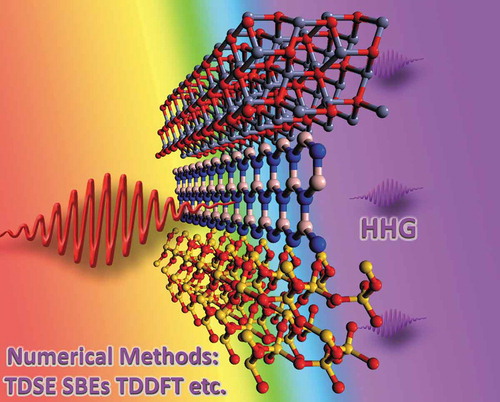Figures & data

Figure 1. HHG from a three-band Houston basis calculation and a 51-band Bloch basis calculation, for intensities of a 3.2-μm driving field: (a) 4.5 × 1011 W/cm2 and (b) 1.0 × 1012 W/cm2. The black thin line is calculated from the conduction band only in the Houston basis. Adapted from Ref. [Citation18].
![Figure 1. HHG from a three-band Houston basis calculation and a 51-band Bloch basis calculation, for intensities of a 3.2-μm driving field: (a) 4.5 × 1011 W/cm2 and (b) 1.0 × 1012 W/cm2. The black thin line is calculated from the conduction band only in the Houston basis. Adapted from Ref. [Citation18].](/cms/asset/812f87c9-996b-4474-9fd7-b6637c089543/tapx_a_1562982_f0001_oc.jpg)
Figure 2. The measured HHG spectrum of solid argon as function of laser intensity using 1333 nm drive laser. (b) Simulated HHG spectrum by solving four-band TDSE model. The energies for the relevant bands at Γ point are illustrated in the inset. The dashed rectangle shows the corresponding range of the experimental data in (a). The dashed white curve indicates the predicted cutoff energy of the second plateau based on the energy difference between field-dressed levels 1 and 3. Adapted from Ref. [Citation54].
![Figure 2. The measured HHG spectrum of solid argon as function of laser intensity using 1333 nm drive laser. (b) Simulated HHG spectrum by solving four-band TDSE model. The energies for the relevant bands at Γ point are illustrated in the inset. The dashed rectangle shows the corresponding range of the experimental data in (a). The dashed white curve indicates the predicted cutoff energy of the second plateau based on the energy difference between field-dressed levels 1 and 3. Adapted from Ref. [Citation54].](/cms/asset/f9d5cb9e-7424-40b8-a190-b8b031f141bb/tapx_a_1562982_f0002_oc.jpg)
Figure 3. (a) Orientation-dependent HHG spectra, redrawn from the experimental data in Ref [Citation43]. (b) Spectra calculated by considering the transition dipole phase from the SBEs method within the simplest 1D two-band model. Adapted from Ref. [Citation72].
![Figure 3. (a) Orientation-dependent HHG spectra, redrawn from the experimental data in Ref [Citation43]. (b) Spectra calculated by considering the transition dipole phase from the SBEs method within the simplest 1D two-band model. Adapted from Ref. [Citation72].](/cms/asset/fef0a434-4f1b-4301-8412-675369bdcb4c/tapx_a_1562982_f0003_oc.jpg)
Figure 4. Simulated harmonic spectrum of ZnO crystal from interband (blue line) and intraband (red line) currents; (a), (b), (c) show dephasing times T2 = ∞, T0/2, T0/4, respectively. T0 = 2π/ω0 = 10.9 fs. The dashed black vertical lines represent the (minimum) band gap at the center of the Brillouin zone. Adapted from Ref. [Citation17].
![Figure 4. Simulated harmonic spectrum of ZnO crystal from interband (blue line) and intraband (red line) currents; (a), (b), (c) show dephasing times T2 = ∞, T0/2, T0/4, respectively. T0 = 2π/ω0 = 10.9 fs. The dashed black vertical lines represent the (minimum) band gap at the center of the Brillouin zone. Adapted from Ref. [Citation17].](/cms/asset/5120714b-c0d0-42fb-a4a4-e056d93502ca/tapx_a_1562982_f0004_oc.jpg)
Figure 5. (a) Simplified band structure schematics consisting of two valence bands h1 and h2 (red lines) and one conduction band e (blue line). The allowed transitions are labeled and marked by black arrows. (b) Schematic of the direct excitation path. The transition h1 to e is marked by the blue arrow. (c) Indirect excitation path consisting of the transition h1 to h2 (red arrow) and h2 to e (three-dimensional red arrow). (d) Full quantum interference (QI): combination of the direct excitation path and the indirect excitation path. Adapted from Ref. [Citation6].
![Figure 5. (a) Simplified band structure schematics consisting of two valence bands h1 and h2 (red lines) and one conduction band e (blue line). The allowed transitions are labeled and marked by black arrows. (b) Schematic of the direct excitation path. The transition h1 to e is marked by the blue arrow. (c) Indirect excitation path consisting of the transition h1 to h2 (red arrow) and h2 to e (three-dimensional red arrow). (d) Full quantum interference (QI): combination of the direct excitation path and the indirect excitation path. Adapted from Ref. [Citation6].](/cms/asset/b0dc0a7e-5bd9-41af-91a6-36e225d12c59/tapx_a_1562982_f0005_oc.jpg)
Figure 6. (a) Simulated orientation-dependent high harmonic spectra from h-BN by using three valence bands and five conduction bands. The peak intensity of laser is 5.0 × 1012 W/cm2, wavelength is 800 nm and pulse duration is 10 optical cycles. (b) Identical to (a) but by selectively turning off the indirect excitation pathways. (c) High harmonic spectra along the high-symmetry directions Γ–M and Γ–K in the Brillouin zone. Adapted from Ref [Citation48].
![Figure 6. (a) Simulated orientation-dependent high harmonic spectra from h-BN by using three valence bands and five conduction bands. The peak intensity of laser is 5.0 × 1012 W/cm2, wavelength is 800 nm and pulse duration is 10 optical cycles. (b) Identical to (a) but by selectively turning off the indirect excitation pathways. (c) High harmonic spectra along the high-symmetry directions Γ–M and Γ–K in the Brillouin zone. Adapted from Ref [Citation48].](/cms/asset/d12a159f-5397-4f3a-b063-b5c339874d54/tapx_a_1562982_f0006_oc.jpg)
Figure 7. (a) Simulated HHG spectra from bulk silicon, for polarization along Γ-X, computed within the LDA (LDA, black line) and within the LDA, but freezing the coulomb and exchange-correlation terms to their ground-state value (LDA-FreezeHXC, red line). (b) The anisotropic HHG spectra calculated from TDDFT model by rotating the laser polarization around the [001] crystallographic direction. Adapted from Ref. [Citation34].
![Figure 7. (a) Simulated HHG spectra from bulk silicon, for polarization along Γ-X, computed within the LDA (LDA, black line) and within the LDA, but freezing the coulomb and exchange-correlation terms to their ground-state value (LDA-FreezeHXC, red line). (b) The anisotropic HHG spectra calculated from TDDFT model by rotating the laser polarization around the [001] crystallographic direction. Adapted from Ref. [Citation34].](/cms/asset/2dff2f1e-a05b-4774-a281-fdf98ec2c9e6/tapx_a_1562982_f0007_oc.jpg)
